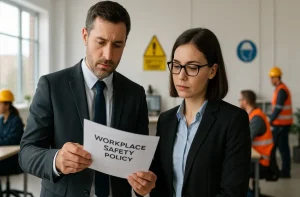In the UK, workplace health and safety is not just a matter of good practice, it’s a legal requirement. Whether you’re managing a large organisation, running a small business, or working as an employee, it’s essential to understand your responsibilities under the law.
You may be wondering, who is responsible for workplace health and safety? The short answer is: everyone has a role to play.
However, employers carry the greatest legal responsibility under the Health and Safety at Work etc. Act 1974. That said, employees, contractors, managers, and even visitors are expected to contribute to creating a safe and healthy working environment.
This blog will guide you through the core responsibilities, relevant legislation, enforcement authorities, and how businesses and individuals alike can foster a safety-first culture.
Why is Workplace Health and Safety a Legal Responsibility in the UK?

Workplace health and safety law in the UK is underpinned by the Health and Safety at Work etc. Act 1974. This landmark piece of legislation places duties on employers to ensure the health, safety, and welfare of their employees and anyone affected by their business operations.
As an employer or business owner, you are legally obliged to prevent workplace risks that could cause injury, ill health, or worse. Failing to meet these obligations can result in criminal prosecution, significant fines, and in severe cases, imprisonment.
The law also allows employees to raise concerns and even refuse to work if they believe they’re in immediate danger. Let’s take a look at a real-life example.
Case Study: Legal Action Following Safety Failings
In 2023, a UK construction company was fined £250,000 after a worker fell through an unprotected floor opening. Investigations revealed that the company had failed to conduct a risk assessment or provide suitable fall prevention measures.
The Health and Safety Executive (HSE) prosecuted the company under the Health and Safety at Work Act, holding senior management accountable for neglecting basic safety procedures.
This case illustrates how non-compliance with legal duties can have dire consequences for both employees and businesses.
What Are the Employer’s Legal Duties in Ensuring Workplace Safety?
As an employer, your responsibilities go far beyond simply putting up safety signs or distributing helmets. You are required to take a proactive approach, identifying and managing risks across your business operations.
How Should Employers Conduct Workplace Risk Assessments?
Risk assessments are the foundation of workplace safety. You need to identify potential hazards, evaluate their severity, and implement measures to eliminate or control those risks. It’s not just about the obvious dangers, risks can include stress, repetitive strain injuries, chemical exposure, or mental health issues.
Assessments should be tailored to the nature of your business. For instance, a warehouse operation might focus on heavy lifting and machinery hazards, while an office setting would assess workstation ergonomics and fire exits.
Risk assessments must be documented if you employ five or more people. They should also be reviewed regularly, especially when changes in procedures, equipment, or staffing occur.
What Must Be Included in a Health and Safety Policy?
By law, if your business has five or more employees, you must create a written health and safety policy. This document should:
- Outline your commitment to health and safety
- Detail how risks are managed
- Identify who is responsible for specific duties
- Include emergency procedures and training plans
Your policy should be clear, accessible, and reviewed periodically. A strong policy is not just a legal requirement, it’s a practical roadmap to a safer workplace.
When Is It Mandatory to Provide PPE and Safety Equipment?
You must provide Personal Protective Equipment (PPE) free of charge when risk assessments identify it as necessary. PPE might include gloves, safety glasses, hearing protection, or respiratory gear.
You also have a duty to ensure it’s maintained, replaced when damaged, and that employees know how to use it properly.
Here’s a comparative table to illustrate PPE responsibilities:
| Responsibility Area | Employer's Duty | Employee's Duty |
|---|---|---|
| Provision of PPE | Must provide suitable PPE at no cost | Must use PPE provided |
| Training | Ensure employees are trained on usage | Follow the training provided |
| Maintenance | Replace or repair damaged PPE | Report any faults or issues |
| Compliance Monitoring | Enforce PPE usage in risk areas | Wear PPE when required |
How Do Employees Share Responsibility for Workplace Health and Safety?

Although the legal onus primarily lies with employers, employees are not exempt from responsibility. You are expected to contribute to a safe environment by adhering to training, using equipment correctly, and alerting management to any hazards.
You should:
- Cooperate with health and safety policies
- Attend relevant training sessions
- Report faulty equipment or unsafe conditions
- Wear PPE when required
- Avoid actions that could endanger others
Your role as an employee is crucial in preventing accidents. Even something as simple as cleaning a spill or reporting a loose cable can make a difference.
What Role Does the Health and Safety Executive (HSE) Play?
The Health and Safety Executive (HSE) is the UK’s national regulator for workplace safety. It is responsible for:
- Setting industry safety standards
- Conducting inspections and investigations
- Providing guidance and training resources
- Enforcing legal compliance
Enforcement and Penalties
HSE has the authority to issue enforcement notices, stop work activities, or take legal action against organisations that breach the law. Depending on the severity of the breach, the penalties may include:
| Violation Type | Possible Penalty |
|---|---|
| Minor breach | Improvement or prohibition notice |
| Serious breach (non-injury) | Fine of up to £20,000 |
| Serious breach (injury/fatal) | Unlimited fines or imprisonment |
In some cases, local authorities may also enforce health and safety law, particularly in sectors like retail or hospitality.
Who Else Is Involved in Workplace Safety Management?
Workplace safety isn’t solely an employer-employee concern. Several other roles contribute to managing risks.
- Safety Representatives: Appointed in unionised workplaces or chosen by employees in smaller businesses, they help communicate concerns and conduct inspections.
- Line Managers & Supervisors: They act as a bridge between leadership and employees, ensuring day-to-day practices align with company policies.
- Contractors and Visitors: You must also ensure that third-party contractors and site visitors are aware of safety procedures and comply accordingly.
Real-World Example: Collaborative Safety in Warehousing
In a logistics company operating in the Midlands, a near-miss involving a forklift prompted a safety overhaul. Management worked with union reps and warehouse staff to redesign traffic routes and implement mandatory spotter roles during high-volume hours.
As a result, incident rates dropped by 40% over the following year, demonstrating the power of collaborative safety management.
How Should Employers Communicate and Train Staff on Health and Safety?

Effective communication and training are not just compliance checkboxes, they’re central to creating an engaged, informed workforce that actively contributes to workplace safety. As an employer, it’s your duty to ensure that your employees fully understand the risks associated with their work and the steps they must take to avoid harm.
Communication should be two-way. While informing staff of policies and updates is essential, it’s equally important to listen to their concerns and feedback.
Regular safety meetings, toolbox talks, and digital communications (like emails or internal platforms) can keep safety at the forefront of daily operations.
Role-Specific Training
Health and safety training must be relevant to each employee’s role. Generic training may miss the mark in high-risk environments, so tailoring sessions based on job functions, departments, or equipment used is crucial.
For example:
| Job Role | Training Type |
|---|---|
| Office Administrator | Fire safety, DSE (Display Screen Equipment) use |
| Construction Worker | Working at height, PPE usage, manual handling |
| Lab Technician | COSHH (Control of Substances Hazardous to Health), chemical spill response |
Incorporating regular refresher training and maintaining training records also helps ensure compliance and demonstrates your organisation’s commitment to continuous improvement.
When Should Employees Report a Health and Safety Concern?
You should report concerns as soon as you identify them. Delays can escalate risks. Whether it’s faulty machinery, missing signage, or unsafe behaviours, it’s your duty to speak up.
Reporting channels can include:
- Your direct supervisor
- The designated safety representative
- A confidential reporting line (if available)
- Direct contact with the HSE in unresolved cases
Employers are legally forbidden from penalising employees who raise legitimate safety concerns. Whistle-blower protections ensure that raising such issues doesn’t put your job at risk.
What Should a Workplace Health and Safety Policy Contain?

A workplace health and safety policy is more than just a formality, it’s a legal and operational necessity that outlines how you manage risks, allocate responsibilities, and comply with UK legislation.
Your policy should be proportionate to the size and nature of your business. For smaller organisations, a concise document may suffice. For larger or higher-risk industries, the policy should be detailed and specific.
A well-structured policy typically includes:
- General Statement of Intent: A commitment from senior management to prioritise health and safety.
- Responsibilities: Clear roles assigned to directors, managers, supervisors, and employees.
- Arrangements: Procedures for risk assessments, emergency responses, training, incident reporting, and equipment maintenance.
Accessibility and Implementation
You must ensure the policy is available to all employees, ideally through induction, staff handbooks, or internal portals. Regular reviews are vital, especially following workplace incidents, structural changes, or legal updates. It’s also advisable to keep a signed and dated version by a senior authority to show genuine accountability.
How Can a Business Create a Culture of Shared Safety Responsibility?
Creating a culture of safety means moving beyond legal compliance to a mindset where safety is embedded in every action. This is achieved through:
- Strong leadership: Senior leaders must visibly prioritise safety.
- Empowered employees: Give staff the tools and confidence to take initiative.
- Recognition and accountability: Acknowledge safe behaviours and hold all staff accountable.
When employees feel that their input matters, they’re more likely to report issues and engage with safety processes. Culture is built over time, but it starts with consistent actions and open dialogue.
Conclusion
So, who is responsible for workplace health and safety? Ultimately, while you as an employer bear the legal weight, everyone involved in your business has a role. Employees, managers, contractors, and safety reps all contribute to creating a healthy, hazard-free workplace.
By understanding the law, implementing best practices, and fostering a proactive safety culture, your business can stay compliant, and more importantly, keep people safe.
Frequently Asked Questions
What are the penalties for breaching health and safety laws in the UK?
Penalties range from improvement notices and fines to imprisonment, depending on the severity of the breach and resulting harm.
How can small businesses manage health and safety effectively?
By focusing on tailored risk assessments, basic training, and appointing responsible staff, small businesses can remain compliant without high costs.
Is a written health and safety policy always required?
A written policy is legally required if you have five or more employees, but it’s good practice for smaller businesses as well.
Can employees refuse to work if they feel unsafe?
Yes. Employees have a legal right to refuse unsafe work under the Employment Rights Act 1996, particularly if there’s an immediate risk.
Who pays for personal protective equipment in the UK workplace?
Employers are legally required to provide necessary PPE at no cost to the employee.
How often should health and safety training be reviewed?
Training should be refreshed regularly, at least annually or when roles, risks, or equipment change.
What’s the difference between HSE and local authorities in enforcement?
HSE oversees high-risk industries like construction, while local councils often handle retail, hospitality, and leisure premises.







